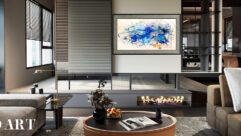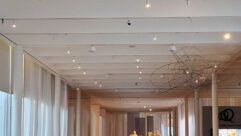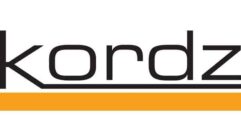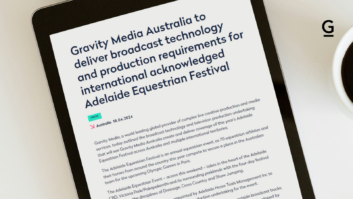PERFORMANCE ART
Jul 1, 2000 12:00 PM,
Keith Clark
Meeting the demanding systems integration needs of the Blue Man Group’s latest installation at the Luxor Theater, Las Vegas.
“Now that Las Vegas has expanded its cultural palette and embraced Broadway-style legitimate theater, it feels like a good time to introduce some illegitimate theater,” said Chris Wink (co-founder with Matt Goldman and Phil Stanton of Blue Man Group) about the recent launch of their latest creation at the Luxor Theater.
For those who have not seen a Blue Man show, illegitimate is only one of thousands of adjectives to describe an experience that defies categorization. With roots stretching back to New York street theater in the late 1980s, the Blue Man concept eventually transferred Off-Broadway at Astor Place Theatre, expanded to productions in Boston, Chicago and now the Vegas strip – the most elaborate creation to date.
An overview: Three bald and, of course, blue performers present a childlike romp that offers a thought-provoking and at times poignant take on art, science, society and life in the information age. By the time it is over, there’s also a big mess – paint splattered, marshmallows thrown, Cap’n Crunch cereal spilled and miles of paper. At several points, scrolling commentary is displayed on LED signs that are part of the set, with an evocative, original soundtrack, heavy on haunting tribal rhythms, performed by a live band in tandem with recorded tracks and effects. A New York Times headline aptly coined the spectacle “High Tech Meets Goo with Blue Man Group.”
Original elements and routines from the other productions maintain a key role in the new show but with the addition of facets and alterations that take things to a whole new level. For example, a backdrop of an enormous neon-like landscape is brought to life on stage, evolving into an intense techno-tribal ritual.
“When Blue Man takes the neon sign and turns it into something else, something primal, exciting and unexpected, this mirrors our goal of transforming the Las Vegas scene by bringing an uncharacteristic and innovative experience to the Strip,” said Stanton.
Music, too, plays an even larger role in the new production, featuring a number of musical instruments developed by Blue Man Group, including backpack tubulums (a musical application of PVC pipe), airpoles and a three-story high drum wall. The band, usually made up of a trio of musicians, has been expanded to seven. They are split between two platform areas above stage left and right, visible to the audience through a scrim. By the way, Blue Man does not speak at any point in the production, letting the actions do the talking.
Club PA
The sound design for the production, officially titled “Blue Man Group Live at Luxor,” comes from Blue Man Group’s Todd Pearlmutter and Ross Humphrey. They conceived two discrete systems working in tandem, one with a standard left-right stereo configuration, the other offering a unique twist on the surround-sound format. Overall, their concept was creation of a club PA type of sonic signature – full, solid, warm and in your face – rather than going with a more esoteric theatrical sound design.
Specialized Audio-Video, Inc. (SAVI), Clifton Park, NY, veterans of nearly a dozen major systems projects with Las Vegas entertainment venues, played the key role in implementing this conceptual design. Headed by Michael Cusick, SAVI worked closely with Pearlmutter and Humphrey to translate their vision into a technical reality. They also provided system installation, a process headed up by Tod Butler, and performed in-depth tuning and analysis.
“The sound design strips away layers of system complexity that had been building up with each new production. It’s back to basics, based in large part on analog components,” Cusick said. “Blue Man Group’s sound, at its essence, is more about drums and rock and roll rather than ethereal sounds moving all over the place.”
The project presented SAVI with a unique creative opportunity, much more freestyle than usual for an effort of this type. The goal was to keep the design as open, undefined and flexible as possible while still providing the requisite structure of any large-scale sound reinforcement system.
“The evolving creative process was fascinating to work with,” Cusick said. “It begins with the three founders and then disseminates down through the entire organization. It’s challenging to try to make something solid and real, like a system, out of a process that is ever-changing, ever in flux and for its own sake, refuses to settle down.
“Unlike Broadway and other theatrical situations, where you’re tying to nail something down completely, put it on paper and get it finalized, the Blue Man approach is one of continuous adaptability. The tendency is to try to force conformity, to say `this is what the system is, and this is what the system does; it’s what you’re getting, so deal with it.’ We disciplined ourselves against this urge and adapted to their more open-ended mentality.”
Near-field quality
Originally designed to resemble Grauman’s Egyptian Theater in Hollywood, the 1,200-seat Luxor Theater, owned and operated by Mandalay Resort Group, underwent a rather radical transformation for the new production, taking on a more spartan, industrial look and feel. Virtually all wall and ceiling spaces are black, either painted or covered by draping fabric, with the sole focal point being the large front stage. The fan-shaped seating configuration sweeping up and back from the stage is divided into two main sections, upper and lower, separated by a wide continuous aisle.
Cusick, already quite familiar with the space as the designer of the venue’s original system, noted that its acoustic signature has always been acceptable, saying that it was not too live, not too dead. Some of the previous system’s Eastern Acoustic Works (EAW) loudspeakers were retained, such as SB-600s housed in special chambers under the stage to supplement the new system’s rather prodigious low-end performance.
Another important design concept is providing every seat with sound of near-field monitoring quality, as much as that is possible in a large theater. The personal nature of the performance lends itself to this approach. At the same time, the solid sonic presence needs to be balanced by controlling levels, ensuring things do not get too loud amid the show’s chaos and that the audience is not plagued by ear fatigue.
Mix and match
Both the main/stereo and surround loudspeaker systems are fueled by close to 200 inputs supplied by no less than five consoles at the house mix position, located centrally just behind the primary aisle. Basically, the main system provides playback of the band, while the surround system handles myriad tracks and effects that enhance a particular mood or environment. There is some mix and match to the approach as well.
Cusick, who regularly uses EAW loudspeakers, noted that they are one of the cornerstones of this project.
“The issue of loudspeakers was settled early in the process. Blue Man Group wanted to get back to its essence, an honest rock music signature, and they were pretty adamant about using EAW loudspeakers to achieve this,” he said. “As it played out, we used EAW exclusively for the entire project.”
The stage is flanked by left and right arrays made up of EAW KF700 series loudspeakers that provide complete coverage of the lower seating section. Each array includes three KF750 three-way loudspeakers above three KF755 specialized downfill modules. Below each array, four SB1000e subwoofers are subtly stacked vertically on stage incorporated into a custom concrete bunker to reduce low-frequency resonance. At the midpoint of the room, approximately above the main aisle, two more stereo arrays are flown left and right. They include four SB750 subwoofers topping four KF755 downfill boxes.
“With its 30 degrees downfiring angle, the KF755 is an outstanding speaker for projects like this. You can build normal array structures while automatically getting the right dispersion to the desired coverage area just by adjusting the height of the array,” Cusick said. “It looks misleading but works extremely well. Coverage is better and with less hassle.”
He added that the delay arrays would not ordinarily be necessary with the KF750s easily able to reach the back rows in rooms of this scale where throw distances are not even 100 feet (2.5 m). They were, however, deemed crucial to foster the desired near-field sense of intimacy expected of the system.
Cross-firing zones
The surround system takes a unique twist on the 5.1 format. Rather than offering a center channel at the front of the listening area, this channel is fed to a grouping of loudspeakers flown from the ceiling at the mid-point of the theater. The group includes four EAW ASV7923 three-way loudspeakers, each firing diagonally across each quadrant of the listening area.
These loudspeakers are mounted together with four EAW BH822 SuperSubs configured in a block and firing straight down. The other surround channels are fed to pairs of EAW ASV series loudspeakers (one long-throw, the other short-throw) flown in each corner of the theater. Obviously, there is some cross-firing between these loudspeakers in their respective coverage zones, but this was done on purpose. The soundtrack was carefully engineered to work with the loudspeaker layout. In fact, mixing was done in a studio set up to emulate the actual sound design as much as possible.
“This is a prime example of the creativity this project exudes,” Cusick said. “Yet another example is the number of subwoofers that are deployed, which would seem to be way too many. However, at times they want an effect where low-frequency energy literally lifts audience members out of their seats, which dictates a lot of air moving and, therefore, requires a significant number of subs distributed in the house.”
SAVI worked with a structural engineering company to fabricate custom steel mounting structures for the grouping of center loudspeakers. The facility offered plenty of amenities for flying and rigging the other loudspeakers and arrays.
All loudspeakers are driven by Crown Macro-Tech Series amps, exclusively, which are distributed among six locations, putting them as close to the loudspeakers as possible. “We used the entire MA line. Reliable power and plenty of it,” Cusick says. “They also offer good reserve power, which is handy in this application because you’re dealing with transient drum sounds.”
Mondo Channels
The soundtrack and surround system is mostly intended to create an environment that tells an understory to what’s happening on stage. It’s also a big part of the finale, where a dynamic disco-dance number called “KLF” is really slamming while strobe lights are going off and paper streams down through the audience.
An Otari Radar multitrack unit, backed up by a Tascam DA-88, delivers the surround soundtrack to a Yamaha 03D digital mixer, one of the few digital pieces incorporated into the design. Located at the front of the mix position, the 03D drives the surround system, handling levels, distribution and programming. Its preset section is a particularly welcome feature. Presets of both main and backup programming can be accessed and switched back and forth quickly.
The main system offers a rather extensive mix situation, with two Soundcraft K3-32 consoles and a Midas Heritage 2000-48 console working in tandem with aYamaha PM3500-48 console that essentially functions as a master section for all of these channels. The Heritage 2000 is dedicated to drums only, with the K3s handling all other instruments and performing auxiliary submix capability. All of these channels are essentially grouped down to specific stereo subgroups, with the PM3500 outfitted with 24 stereo modules in order to supply enough inputs.
“The 48 channels of the Heritage 2000 are dedicated exclusively to four drum kits only, each with 12 microphones,” Cusick said. “Todd and Ross really like the analog sound of this board’s preamps and EQ section, particularly because it’s friendly to drum sounds. They wanted drums to be as fat as possible.”
An ample amount of Drawmer DS-404 gates play an influential role with the drums as well. In general, their sonic signature led to their use, along with an additional benefit of being tuneable, which fit well with the flexibility concept. An Aphex 9000 series modular processing frame also plays an important role, able to be loaded with a wide range of modules supplying compression, limiting, gating and other processing as needed.
A foldback system for the stage includes four 56-pair splits to an AMEK Recall console retained from the previous system. In addition to 16 submixes derived from the mix position, every stage input is available with a number of other feeds supplied discretely.
The three Blue Man performers are outfitted with Shure in-ear monitoring systems, with additional foldback support supplied by a few stage wedges concealed in the set. Band members usually rely upon David Clark Silencer headphones outfitted with Sony ear pieces to supply as much isolation as possible from the often considerable ambient noise. Headphones are driven by several Miles Technology MPR-450 six-channel power amps.
Sparsely Digital
The only other concession to digital technology came in the form of XTA DP226 processors, used for all house loudspeakers. Distributed among the amp racks, the DP226s are networked (via RS-485) on a loop established in the multicable subsystem. Cusick pointed out that there just is not an analog equivalent to this approach.
“In terms of both wiring infrastructure and complexity, as well as processing capabilities, there really isn’t an analog tool that can do the job,” he said. “But everything else is kept analog, without any A-D or D-A conversion. Their feeling is that digital conversion doesn’t lend itself to the sonic signature of the show.”
Additional main system tailoring can be done at any time with a Klark-Teknik DN3600 digitally controlled analog EQ inserted at front of house. This can be done within specific zones or system-wide.
The XTA network also proved beneficial during the system tuning process following installation. A laptop PC was linked to the network, allowing parameter tailoring from the front of house position as SAVI performed acoustical measurement and analysis with SIA Smaart Pro v4.0 software on another laptop PC.
With various mic positions established throughout the room, Smaart helped analyze the output of each loudspeaker with performance optimized painstakingly over several days. The overall objective was delivering a system with response as flat as possible, and then letting the Blue Man staff take it from there with the DN3600.
“They brought about a certain change and alteration in color that we couldn’t have necessarily done,” Cusick said. “Our scientific approach served as the foundation, and they added the emotion. It was an interesting combination, an ideal marriage of the two methods.
“This was a very rewarding project, feeding off of the sheer creativity of the Blue Man organization – Ross and Todd in particular – and helping them transfer their vision into these systems. The results have been equally rewarding. Often in your face, but never too loud, with the overall soundscape hallmarked by superior clarity and presence, enhancing what’s happening on stage. It’s analog. It’s warm. It’s in your face, but mostly, it’s just good.”










